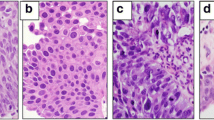Abstract
Prognostic assessment of bladder carcinomas of intermediate differentiation is difficult. This study therefore investigated the prognostic values of nucleolar status and silver staining of argyrophilic nucleolar organizer regions (AgNORs) in grade II bladder carcinomas. In biopsies from 34 grade II transitional cell carcinomas of the urinary bladder the number of nuclei with nucleoli, the location of nucleoli within the nucleus and the number of AgNORs were determined in 1000 or 200 nuclei per section respectively. Ten biopsies showing normal urothelium, 18 cases with mild to severe atypia, 27 grade I, 34 grade II and 12 grade III transitional cell carcinomas were also studied. Significantly differing nucleolar and AgNOR values were found comparing normal urothelium/grade I carcinomas with severe urothelial atypia/grade III carcinomas. Grade II carcinomas, however, were inhomogeneous. One subgroup had nucleolar and AgNOR values resembling grade I carcinomas while the second group had values similar to those of grade III carcinomas. This subdivision of grade II carcinomas correlates with results reported for DNA-cytometry. The results suggest a subdivision of patients with grade II transitional cell carcinomas into a low risk and high risk group.
Similar content being viewed by others
References
Blomjous CEM, Schipper NW, Vos W, Baak JPA, Voogt HJ de, Meijer CJLM (1989) Comparison of quantitative and classic prognosticators in urinary bladder carcinoma. A multivariate analysis of DNA flow cytometric, nuclear morphometric and clinicopathological features. Virchows Arch [A] 415:421–428
Blomjous CEM, Vos W, Schipper NW, Uyterlinde AM, Baak JPA, Voogt HJ de, Meijer CJLM (1990) The prognostic significance of selective nuclear morphometry in urinary bladder carcinoma. Hum Pathol 21:409–413
Borgmann V, Al-Abadi H, Nagel R (1991) Prognostic relevance of DNA ploidy and proliferative activity in urothelial carcinoma of the renal pelvis and ureter. A study on a follow-up period of 6 years. Urol Int 47:7–11
Cairns P, Suarez V, Newmann J, Crocker J (1989) Nucleolar organizer regions in transitional cell tumors of the bladder. Arch Pathol Lab Med 113:1250–1252
Crocker J (1990) Nucleolar organizer regions. Curr Top Pathol 82:91–149
Hansen AB, Bjerregaard B, Ovesen H, Horn T (1992) AgNOR counts and histological grade in stage pTa bladder tumours: reproducibility and relation to recurrence pattern. Histopathology 20:257–262
Helander KG, Tribukait B (1988) Modal DNA values of normal and malignant urothelial cells of the bladder in relation to nuclear size. Anal Quant Cytol Histol 10:127–133
Helpap B (1988) Observations on the number, size and localization of nucleoli in hyperplastic and neoplastic prostatic disease. Histopathology 12:203–211
Helpap B (1989) Nucleolar grading of breast cancer. Comparative studies on frequency and localization of nucleoli and histology, stage, hormonal receptor status and lectin histochemistry. Virchows Arch [A] 415:501–508
Helpap B (1992) Grading and prognostic significance of urologic carcinomas. Urol Int 48:245–257
Helpap B, Knüpfer J, Essmann S (1990) Nculeolar grading of renal cancer. Correlation of frequency and localization of nucleoli to histologic and cytologic grading and stage of renal cell carcinomas. Mod Pathol 3:671–678
Helpap B, Vogel J, Oehr P, Adolphs HD (1985) Comparison between cell kinetic immunohistochemical studies on carcinoma and atypia/dysplasia of urinary bladder mucosa. Virchows Arch [A] 406:309–322
Hermanek P, Sobin LH (1992) TNM classification of malignant tumours, 4th edn, 2nd revision. Springer, Berlin Heidelberg New York
Kirkhus B, Clausen OPF, Fjordvang H, Helander K, Iversen OH, Reitan JB, Vaage S (1988) Characterization of bladder tumours by multiparameter flow cytometry with special reference to grade II tumours. APMIS 96:783–792
Kramer CE, Epstein JJ (1992) Nucleoli in low-grade prostate adenocarcinoma and adenosis. Hum Pathol 24:618–623
Langkilde NC, Wolf H, Orntoft TE (1989) Binding of wheat and peanut lectins to human transitional cell carcinomas. Correlations with histopathologic grade, invasion and DNA ploidy. Cancer 64:849–853
Martin H, Hufnagl P, Wenzelides K, Beil M (1991) AgNORs in cells of urothelial carcinomas of the bladder: quantitative investigation, using automated microscopic image analysis. Zentralbl Allg Pathol 137:505–509
Martin H, Hufnagl P, Beil M, Wenzelides K, Gottschalf K, Rahn W (1992) Nucleolar organizer region-associated proteins in cancer cells. Quantitative investigations on gliomas, meningiomas, urinary bladder carcinomas and pleural lesions. Anal Quant Cytol Histol 14:312–319
Montironi R, Braccischi A, Matera G, Scarpelli M, Pisani E (1991) Quantitation of the prostatic intraepithelial neoplasia. Analysis of the nucleolar size, number and location. Pathol Res Pract 187:307–314
Mostofi FK, Sobin LH, Torloni H (1973) Histological typing of urinary bladder tumours. International histological classification of tumours, vol 10. World Health Organization, Geneva
Pich A, Chiusa L, Comino A, Navone R (1994) Cell proliferation indices, morphometry and DNA flow cytometry provide objective criteria for distinguishing low and high grade bladder carcinomas. Virchows Arch [A] 424:143–148
Ploton D, Menager M, Jeannesson P, Himber G, Pigeon F, Adnet JJ (1986) Improvement in the staining and in the visualization of the argyrophilic proteins of the nucleolar organizer region at the optical level. Histochem J 18:5–14
Rüschoff J, Zimmermann R, Ulshöfer B, Thomas C (1992) Silver-stained nucleolar organizer proteins in urothelial bladder lesions. A morphometric study. Pathol Res Pract 188:593–598
Shimazui T, Kenkichi K, Uchiyama Y (1990) Morphometry of nucleoli as an indicator for grade of malignancy of bladder tumours. Virchows Arch [B] 59:179–183
Skopelitou A, Korkolopoulou P, Papanicolaou A, Christoddoulou P, Thomas-Tasgli E, Pavlakis K (1992) Comparative assessment of proliferating cell nuclear antigen immunostaining and of nucleolar organizer region staining in transitional cell prognostic pathologic parameters. Eur Urol 22:235–240
Tribukait B (1987) Flow cytometry in assessing the clinical aggressiveness of genito-urinary neoplasms. World J Urol 5:108–122
Author information
Authors and Affiliations
Rights and permissions
About this article
Cite this article
Helpap, B., Loesevitz, L. & Bulatko, A. Nucleolar and argyrophilic nucleolar organizer region counts in urothelial carcinomas with special emphasis on grade II tumors. Vichows Archiv A Pathol Anat 425, 265–269 (1994). https://doi.org/10.1007/BF00196149
Received:
Accepted:
Issue Date:
DOI: https://doi.org/10.1007/BF00196149




